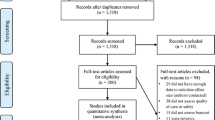Abstract
The purpose of this study is to examine the relationships among variables identified in research literature as obstacles and benefits to interprofessional collaboration-- academic education, interprofessional education, teamwork and communication skills, and trust---as it relates to the participation of clergypersons in interprofessional collaborative practice. The sample consisted of ordained Christian clergypersons in Florida who voluntarily completed a survey questionnaire. Standard and stepwise multiple regression was applied to analyze the data. The model accounts for 25% of the variation of interprofessional collaborative practice. Results also revealed that the education variables explained significantly 20% of the variance of interprofessional collaborative practice.
Similar content being viewed by others
References
Abramson, J. S., & Mizrahi, T. (1996). When social workers and physicians collaborate: Positive and negative interdisciplinary experiences. Social Work, 41, 270–281.
Badger, L. W., Ackerson, B., Buttell, F., & Rand, E. H. (1997). The case for integration of social work psychosocial services into rural primary care practice. Health and Social Work, 22, 20–29.
Billups, J. O. (1987). Interprofessional team process. Theory into Practice, 26, 146–152.
Blank, M. B., Mahmond, M., Fox, J. C., & Guterbock, T. (2002). Alternative mental health services: The role of the Black church in the South. American Journal of Public Health, 92, 1668–1672.
Bronfenbrenner, U. (1979). The ecology of human development. Cambridge, MA: Harvard University Press.
Bubolz, M. M., & Soltag, M. S. (1993). Human ecology theory. In P. Boss, W. Doherty, R. LaRossa, W. Schuum, & S. Steinmetz (Eds.), Sourcebook of family theories and methods: A contextual approach (pp. 419–448). New York: Plenum.
Chatters, L. M., Taylor, R. J., Lincoln, K. D., & Schroepfer, T. (2002). Patterns of informal support from family and church members among African Americans. Journal of Black Studies, 33, 66–85.
Cohen, J. (1992). A power primer. Psychological Bulletin, 112, 155–159.
Edwards, L. C., Brian, L., McMinn, M. R., & Dominguez, A. W. (1999). Examples of collaboration between psychologists and clergy. Professional Psychology: Research and Practice, 30, 547–551.
Geva, E., Barsky, A., & Westernoff, F. (2000). Developing a framework for interprofessional and diversity informed practice. In E. Geva, A. Barsky, & F. Westernoff (Eds.), Interprofessional practice with diverse populations: Cases in point (pp. 1–28). Westpoint, CT: Auburn House.
Hall, P. (2005). Interprofessional teamwork: Professional cultures as barriers. Journal of Interprofessional Care, 1, 188–196.
Kainz, K. (2002). Barriers and enhancements to physician-psychologist collaboration. Professional Psychology: Research and Practice, 33, 169–175.
Mannon, J. D., & Crawford, R. L. (1996). Clergy confidence to counsel and their willingness to refer to mental health professionals. Family Therapy, 23, 213–231.
McMinn, M. R., Chaddock, T. P., Edwards, L. C., Brian, L. R., & Campbell, C. D. (1998). Psychologists collaborating with clergy. Professional Psychology: Research and Practice, 29, 564–570.
McMinn, M. R., Aikins, D. C., & Lish, R. A. (2003). Basic and advanced competence in collaborating with clergy. Professional Psychology: Research and Practice, 34, 197–202.
Mizrahi, T., & Abramson, J. S. (2000). Collaboration between social workers and physicians: Perspectives on a shared case. Social Work in Health Care, 31, 1–24.
Moran, M., Flannelly, F., Weaver, A., Overvold, J., Hess, W., & Wilson, J. (2005). A study of pastoral care, referral, and consultation practices among clergy in four settings in the New York City area. Pastoral Psychology, 53, 255–266.
Nicholson, D., Artz, S., Armitage, A., & Fagan, J. (2000). Working relationships and outcomes in multidisciplinary collaborative practice settings. Child and Youth Care Forum, 29, 39–73.
Oppenheimer, J., Flannelly, K., & Weaver, A. (2004). A comparative analysis of the psychological literature on collaboration between clergy and mental-health professionals—perspectives from secular and religious journals: 1970–1999. Pastoral Psychology, 53, 153–162.
Pollard, K. C., Miers, M. E., & Gilchrist, M. (2004). Collaborative learning for collaborative working: Initial findings from a longitudinal study of health and social care students. Health & Social Care in the Community, 12, 346–358.
Pollard, K., Miers, M. E., & Gilchrist, M. (2005). Second year skepticism: Pre-qualifying health and social care students’ midpoint self-assessment, attitudes and perceptions concerning interprofessional learning and working. Journal of Interprofessional Care, 19, 251–268.
Random House Webster’s College Dictionary (2nd ed.). (1997). New York: Random House.
Snyder, D. K., & Mangrum, L. F. (1996). Approaches to prediction: Correlation, regression, and discriminant analysis. In D. H. Sprenkle & S. M. Moon (Eds.), Research methods in family therapy (pp. 307–335). New York, NY: Guilford Press.
Tate, R. (1998). An introduction to modeling outcomes in the behavioral and social sciences (2nd ed.). Boston, MA: Pearson Custom Publishing.
Weaver, A. J. (1995). Has there been a failure to prepare and support parish-based clergy in their role as front-line community mental health workers? A review. Journal of Pastoral Care, 49, 129–149.
Weaver, A. J., Koenig, H. G., & Larson, D. B. (1997). Marriage and family therapists and the clergy: A need for clinical collaboration, training, and research. Journal of Marital and Family Therapy, 23, 13–25.
Weaver, A. J., Flannelly, K. J., Flannelly, L. T., & Oppenheimer, J. E. (2003). Collaboration between clergy and mental health professionals: A review of professional health care journals from 1980 through 1999. Counseling and Values, 47, 162–171.
Williams, C., Bracht, N. F., Williams, R. A., & Evans, R. L. (1978). Social work and nursing in hospital settings: A study of interprofessional experiences. Social Work in Health Care, 3, 311–322.
Young, J., Griffith, E., & Williams, D. (2003). The integral role of pastoral counseling by African American clergy in community mental health. Psychiatric Services, 54, 688–692.
Author information
Authors and Affiliations
Corresponding author
Rights and permissions
About this article
Cite this article
Thomas, M.L. The Interprofessional Collaborative Practice: Clergypersons and Mental Health Professionals. Pastoral Psychol 61, 99–112 (2012). https://doi.org/10.1007/s11089-011-0408-x
Published:
Issue Date:
DOI: https://doi.org/10.1007/s11089-011-0408-x




